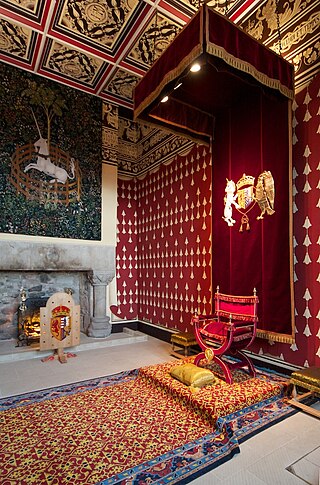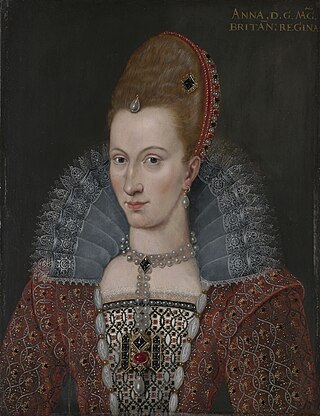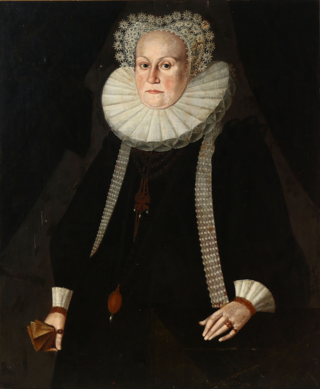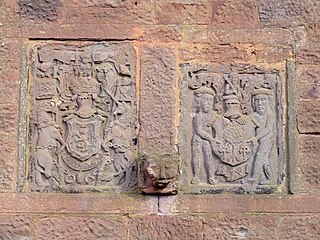
Dunfermline Palace is a ruined former Scottish royal palace and important tourist attraction in Dunfermline, Fife, Scotland. It is currently, along with other buildings of the adjacent Dunfermline Abbey, under the care of Historic Environment Scotland as a scheduled monument.
The Octavians were a financial commission of eight in the government of Scotland first appointed by James VI on 9 January 1596.
Sir George Home of Wedderburn was briefly Comptroller of the Scottish Exchequer in the household to James VI of Scotland.
Jean Fleming, Countess of Cassilis (1553/4–1609) was a Scottish noblewoman and courtier at the court of James VI of Scotland, and a survivor of domestic violence.
Helenor Hay, Countess of Linlithgow was a Scottish courtier and writer.

The masque at the baptism of Prince Henry was a celebration at the christening of Prince Henry at Stirling Castle, written by the Scottish poet William Fowler and Patrick Leslie, 1st Lord Lindores.
Johannes Sering or Johan Seringius was a chaplain to Anne of Denmark in Scotland and England.

On 17 May 1590, Anne of Denmark was crowned Queen of Scotland. There was also a ceremony of joyous entry into Edinburgh on 19 May, an opportunity for spectacle and theatre and allegorical tableaux promoting civic and national identities, similar in many respects to those performed in many other European towns. Celebrations for the arrival of Anne of Denmark in Scotland had been planned and prepared for September 1589, when it was expected she would sail from Denmark with the admirals Peder Munk and Henrik Gyldenstierne. She was delayed by accidents and poor weather and James VI of Scotland joined her in Norway in November. They returned to Scotland in May 1590.
Julian Goodare is a professor of history at University of Edinburgh.

Wilhelm von der Wense was a German-speaking courtier and Danish diplomat serving Sophie of Mecklenburg-Güstrow.

Jemma Field is a historian and art historian from New Zealand. She studied for her PhD with Erin Griffey at the University of Auckland. She was subsequently a Marie Skłodowska-Curie postdoctoral fellow at Brunel University, London. She is currently Associate Director of Research at the Yale Center for British Art.

Queen Elizabeth I of England paid a subsidy to King James VI of Scotland from 1586 to 1602. This enabled her to influence James by delaying or deferring payments to his diplomats in London. Records survive of the yearly amounts, and details of the expenditure in some years. A large proportion of the money was spent on the royal wardrobe of James and Anne of Denmark. Some royal expenses were met by Anne of Denmark's dowry, which was known as the "tocher". The regular incomes of the Scottish crown were feudal rents, customs, and "compositions" charged on grants of land. Accounts for royal incomes and payments survive as the exchequer rolls and lord treasurer's accounts and have been published as historical sources.

The jewels of Anne of Denmark (1574–1619), wife of James VI and I and queen consort of Scotland and England, are known from accounts and inventories, and their depiction in portraits by artists including Paul van Somer. A few pieces survive. Some modern historians prefer the name "Anna" to "Anne", following the spelling of numerous examples of her signature.

Margaret Seton, Lady Paisley was a Scottish aristocrat, courtier and a favourite of Anne of Denmark.
Catherine Murray was a Scottish aristocrat and courtier.
SirRobert Mure or Muir was a Scottish landowner, imprisoned by James VI for intimidating his tenants.

Margaret Wood was a Scottish Catholic courtier. She was a daughter of Patrick Wood, Laird of Bonnyton and Nicholas Wardlaw, Lady Bonnyton, who was a daughter of Henry Wardlaw of Torrie and a former lady in waiting to Mary, Queen of Scots.
Hans Poppilman was a Danish cook who served Anne of Denmark in Scotland and England.

Anne of Denmark (1574–1619) was the wife of King James VI and I, and as such Queen of Scotland from their marriage by proxy on 20 August 1589 and Queen of England and Ireland from 24 March 1603 until her death in 1619. When Anne intended to sail to Scotland in 1589 her ship was delayed by adverse weather. Contemporary superstition blamed the delays to her voyage and other misfortunes on "contrary winds" summoned by witchcraft. There were witchcraft trials in Denmark and in Scotland. The King's kinsman, Francis Stewart, 5th Earl of Bothwell came into suspicion. The Chancellor of Scotland John Maitland of Thirlestane, thought to be Bothwell's enemy, was lampooned in a poem Rob Stene's Dream, and Anne of Denmark made Maitland her enemy. Historians continue to investigate these events.
Matthew Hairstanes was a Scottish courtier.









